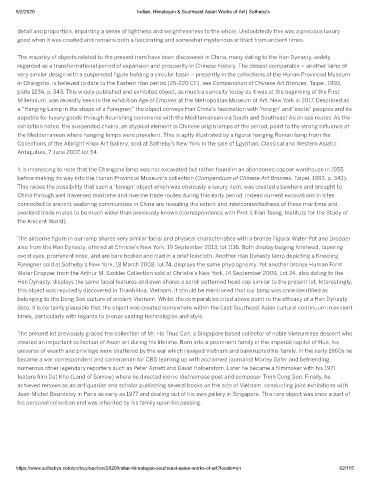Page 62 - 2020 Sept 22 Himalayin and Indian Works of Art Sotheby's NYC Asia Week
P. 62
9/2/2020 Indian, Himalayan & Southeast Asian Works of Art | Sotheby's
detail and proportion, imparting a sense of lightness and weightlessness to the whole. Undoubtedly this was a precious luxury
good when it was created and remains both a fascinating and somewhat mysterious artifact from ancient times.
The majority of objects related to the present item have been discovered in China, many dating to the Han Dynasty, widely
regarded as a transformational period of expansion and prosperity in Chinese history. The closest comparable – another lamp of
very similar design with a suspended figure holding a circular basin – presently in the collections of the Hunan Provincial Museum
in Changsha, is believed to date to the Eastern Han period (25-220 CE), see Compendium of Chinese Art Bronzes, Taipei, 1993,
plate 1234, p. 343. This widely published and exhibited object, as much a curiosity today as it was at the beginning of the First
Millennium, was recently seen in the exhibition Age of Empires at the Metropolitan Museum of Art, New York in 2017. Described as
a “Hanging Lamp in the shape of a Foreigner,” the object conveys Han China’s fascination with ‘foreign’ and ‘exotic’ peoples and its
appetite for luxury goods through flourishing commerce with the Mediterranean via South and Southeast Asian sea routes. As the
exhibition noted, the suspended chains, an atypical element in Chinese origin lamps of the period, point to the strong influence of
the Mediterranean where hanging lamps were prevalent. This is aptly illustrated by a figural hanging Roman lamp from the
Collections of the Albright Knox Art Gallery, sold at Sotheby’s New York in the sale of Egyptian, Classical and Western Asiatic
Antiquities, 7 June 2007, lot 54.
It is interesting to note that the Changsha lamp was not excavated but rather found in an abandoned copper warehouse in 1955
before making its way into the Hunan Provincial Museum’s collection (Compendium of Chinese Art Bronzes, Taipei, 1993, p. 343).
This raises the possibility that such a ‘foreign’ object which was obviously a luxury item, was created elsewhere and brought to
China through well traversed maritime and riverine trade routes during this early period. Indeed current excavations in sites
connected to ancient seafaring communities in China are revealing the extent and interconnectedness of these maritime and
overland trade routes to be much wider than previously known (correspondence with Prof. Lillian Tseng, Institute for the Study of
the Ancient World).
The airborne figure in our lamp shares very similar facial and physical characteristics with a bronze Figural Water Pot and Dropper
also from the Han Dynasty, offered at Christie’s New York, 19 September 2013, lot 1116. Both display bulging forehead, tapering
ovoid eyes, prominent nose, and are bare bodied and clad in a brief loincloth. Another Han Dynasty lamp depicting a Kneeling
Foreigner sold at Sotheby’s New York, 18 March 2008, lot 74, displays the same physiognomy. Yet another bronze Human Form
Water Dropper from the Arthur M. Sackler Collection sold at Christie’s New York, 14 September 2009, Lot 24, also dating to the
Han Dynasty, displays the same facial features and even shares a scroll patterned head cap similar to the present lot. Interestingly,
this object was reputedly discovered in Thanh Hoa, Vietnam. It should be mentioned that our lamp was once identified as
belonging to the Dong Son culture of ancient Vietnam. Whilst the comparables cited above point to the efficacy of a Han Dynasty
date, it is certainly plausible that the object was created somewhere within the East-Southeast Asian cultural continuum in ancient
times, particularly with regards to bronze casting technologies and style.
The present lot previously graced the collection of Mr. Ha Thuc Can, a Singapore based collector of noble Vietnamese descent who
created an important collection of Asian art during his lifetime. Born into a prominent family in the imperial capital of Hue, his
universe of wealth and privilege were shattered by the war which ravaged Vietnam and bankrupted his family. In the early 1960s he
became a war correspondent and cameraman for CBS teaming up with acclaimed journalist Morley Safer and befriending
numerous other legendary reporters such as Peter Arnett and David Halberstam. Later he became a filmmaker with his 1971
feature film Dat Kho (Land of Sorrow) where he directed iconic Vietnamese poet and composer Trinh Cong Son. Finally, he
achieved renown as an antiquarian and scholar publishing several books on the arts of Vietnam, conducting joint exhibitions with
Jean-Michel Beurdeley in Paris as early as 1977 and dealing out of his own gallery in Singapore. This rare object was once a part of
his personal collection and was inherited by his family upon his passing.
https://www.sothebys.com/en/buy/auction/2020/indian-himalayan-southeast-asian-works-of-art?locale=en 62/115

